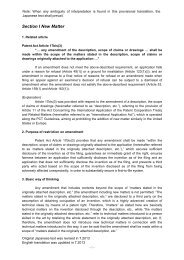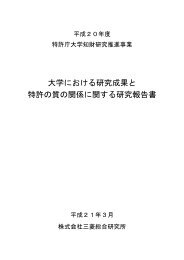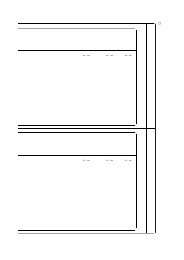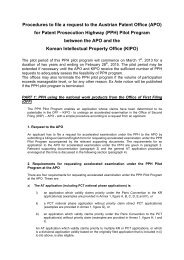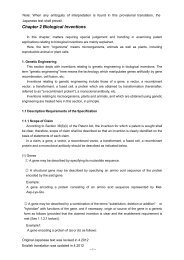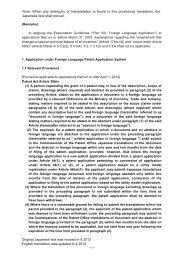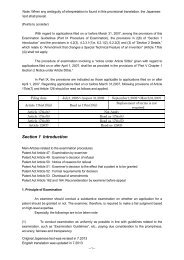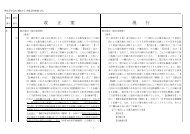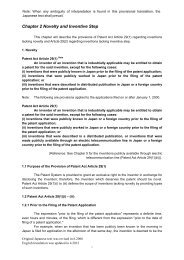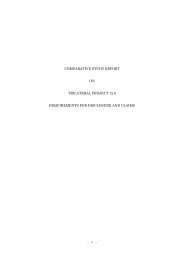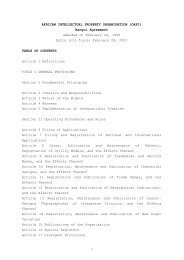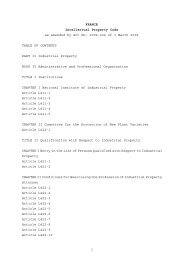Requirements for Unity of Application - Japan Patent Office
Requirements for Unity of Application - Japan Patent Office
Requirements for Unity of Application - Japan Patent Office
You also want an ePaper? Increase the reach of your titles
YUMPU automatically turns print PDFs into web optimized ePapers that Google loves.
[Example 18]<br />
[Title <strong>of</strong> the Invention]<br />
Bond <strong>for</strong> molding and coated sand <strong>for</strong> molding<br />
[Claims]<br />
1. A bond <strong>for</strong> molding, wherein polyacrylamide is dissolved in water or quick-drying solvent.<br />
2. Coated sand <strong>for</strong> molding, which is covered with the bond <strong>for</strong> molding whereby<br />
polyacrylamide is dissolved in water or quick-dry solvent.<br />
[Excerpt from Detailed Description <strong>of</strong> the Invention]<br />
This invention mainly relates to a bond <strong>for</strong> molding used <strong>for</strong> die-casting, like light alloy<br />
castings, where the temperature <strong>of</strong> the hot water <strong>for</strong> pouring is relatively low, and coated sand<br />
<strong>for</strong> molding which is covered with said bond.<br />
Though a light alloy casting is generally manufactured by die-casting, the mold used <strong>for</strong> the<br />
core is manufactured by blowing sand usually coated with phenol resin and/or the like in a<br />
model die. In the case <strong>of</strong> the light alloy casting manufactured by using thermo-setting synthetic<br />
resin as a bond, due to the low temperature (e.g. about 700℃,) <strong>of</strong> the hot water <strong>for</strong> pouring, it is<br />
possible that the thermal dematter <strong>of</strong> the bond made from thermo-setting synthetic resin may be<br />
insufficient and that the core may also be hard or unable to be extruded because the<br />
polymerization <strong>of</strong> the bond is conversely accelerated. The advantage <strong>of</strong> the present invention,<br />
wherein poly-acrylamide is dissolved in the solvent, is excellent in a number <strong>of</strong> respects,<br />
including strength, heat resistance, disintegration characteristics and productivity.<br />
[Explanation]<br />
Though the technical fields <strong>of</strong> the specified invention (Claim 1) and the related invention<br />
(Claim 2) are respectively “a bond <strong>for</strong> molding” and “coated sand <strong>for</strong> molding”, it is highly<br />
appropriate that the art <strong>of</strong> the <strong>for</strong>mer should be applied to the technical field <strong>of</strong> the latter,<br />
because the sand <strong>for</strong> molding is covered with the bond. Accordingly, the technical fields <strong>of</strong> both<br />
inventions are technically and directly associated with each other, and the industrial fields <strong>of</strong><br />
application <strong>of</strong> them are also the same.<br />
In addition, a bond <strong>for</strong> molding which is a new matter corresponding to the problem to be<br />
solved <strong>of</strong> the specified invention is equivalent to the substantial part <strong>of</strong> the matter in the claim <strong>of</strong><br />
the related invention; there<strong>for</strong>e the substantial parts <strong>of</strong> matters in the claims <strong>of</strong> the two<br />
inventions are the same.<br />
[Concerned Section]<br />
<strong>Patent</strong> Law Section 37(ii)<br />
46



